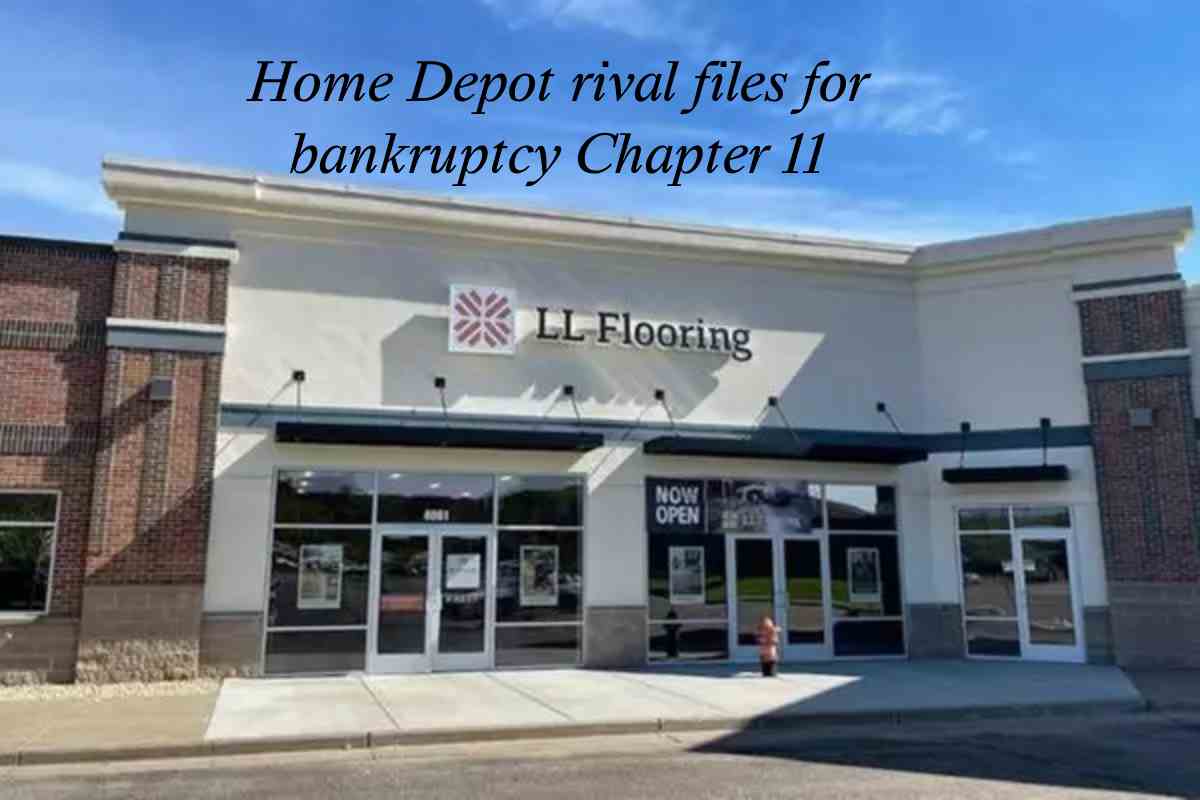When a major Home Depot rival files for bankruptcy Chapter 11, it sends shockwaves through the entire home improvement industry. From supply chain partners to local communities, everyone feels the impact when a once-strong retail competitor suddenly collapses under financial pressure. In this article, I’ll break down what led to this bankruptcy, what Chapter 11 actually means, and how it could reshape the home improvement landscape going forward.
The Big Story: Home Depot Rival Files for Chapter 11
In 2024, LL Flooring — formerly known as Lumber Liquidators — officially filed for Chapter 11 bankruptcy protection. The filing came after months of financial strain, declining sales, and a heavy debt load that became impossible to manage.
The company reported having assets between $500 million and $1 billion and liabilities of around $100 million to $500 million. It also announced plans to close nearly 94 underperforming stores while seeking a buyer to take over its remaining operations.
To stay afloat during restructuring, LL Flooring secured debtor-in-possession (DIP) financing, allowing it to continue operations while the court supervises its financial reorganization. The company’s goal? A “going-concern sale,” meaning it hopes to sell itself (or parts of itself) in a way that keeps stores open and employees working.
Another major development in this space came when True Value Company, a well-known hardware wholesaler, also filed for Chapter 11. And in 2025, At Home Group, a large home décor retailer, joined the list — signaling widespread stress across the entire home and hardware retail sector.
Why It Happened: The Real Causes Behind the Collapse
Let’s face it — when a big company goes bankrupt, it’s rarely about one single reason. It’s usually a combination of bad timing, market shifts, and rising costs. Here are the top factors that pushed LL Flooring and others to this breaking point:
1. Post-Pandemic Slowdown
During the COVID lockdowns, everyone was suddenly obsessed with home projects. Sales of flooring, paint, and tools exploded. But once things reopened, people stopped spending on renovations. The demand crash hit hard — and companies that had expanded too quickly suddenly found themselves overextended.
2. High Inflation and Supply Chain Chaos
The cost of wood, shipping, and fuel skyrocketed after 2021. LL Flooring faced massive price hikes for raw materials and transport. Since competition kept prices tight, it couldn’t pass those costs to customers, crushing profit margins.
3. Too Much Debt
Many retailers borrowed heavily during their growth years. When interest rates started climbing, those debt payments became unbearable. With less revenue and higher costs, servicing that debt became impossible — a perfect storm.
4. Too Many Stores
Another problem? Overexpansion. LL Flooring operated hundreds of stores across the U.S., but not all were profitable. As foot traffic declined, the company had to make tough calls — closing nearly 100 stores to cut losses.
5. Fierce Competition
Home Depot and Lowe’s dominate the home improvement market. Smaller chains like LL Flooring simply couldn’t compete with their massive inventory, marketing budgets, and online presence. Add to that online retailers like Amazon, and competition became brutal.
6. Consumer Spending Shifts
Rising interest rates and living costs have forced many people to delay or cancel renovation projects. As consumer spending slowed, so did sales of flooring and home materials.
What Chapter 11 Really Means
When you hear “bankruptcy,” most people think it means a company is finished. But Chapter 11 bankruptcy is different. It’s actually a legal way for a company to reorganize its debts and try to survive — not immediately shut down.
Here’s what typically happens during a Chapter 11 process:
- The company continues operating under court supervision.
- It uses DIP financing to keep paying employees and suppliers.
- It negotiates with creditors to reduce or restructure debt.
- It may close unprofitable stores and sell some assets.
- It can seek buyers for the entire business or parts of it.
In the case of LL Flooring, the company’s management hopes to find a buyer willing to keep many stores open. This is called a “going-concern sale.”
If no suitable buyer is found or the restructuring fails, the business could be forced into liquidation under Chapter 7, where assets are sold off completely.
The Ripple Effect: Who’s Affected
1. Employees
Thousands of employees are directly impacted by the closures. While some may be retained by new owners, others face layoffs and uncertain futures.
2. Suppliers
Local suppliers and manufacturers that provided flooring, tools, or fixtures lose a major buyer. Many become unsecured creditors — meaning they may never get fully paid for what they’re owed.
3. Customers
For customers, the closure can mean delayed orders, canceled warranties, or difficulties with returns. It’s always smart to act quickly if you have pending deliveries or warranty claims.
4. Communities
Each closed store leaves behind empty buildings and lost jobs, which can hurt local economies. Vacant retail spaces often stay empty for months, reducing foot traffic and property values nearby.
5. Competitors
Ironically, Home Depot and Lowe’s could benefit in the short term. Fewer competitors mean they can strengthen their market share, attract new customers, and negotiate better supplier contracts.
The Bigger Picture: The Industry Is Changing
The collapse of a Home Depot rival shows a major shift in how Americans spend money on home improvement. Here’s what’s changing:
- DIY Decline: With fewer people working from home and tighter budgets, the do-it-yourself boom has cooled off.
- Digital Transformation: Retailers that rely only on physical stores are falling behind. Online ordering, curbside pickup, and digital consultations are now the norm.
- Sustainability Focus: Eco-friendly and energy-efficient products are gaining traction. Companies failing to innovate in that direction risk becoming irrelevant.
- Real Estate Slowdown: With mortgage rates high, fewer people are buying or renovating homes — and that directly hits home improvement sales.
These factors together create an industry shake-up that even well-known brands struggle to handle.
Can They Recover?
There’s still hope for companies like LL Flooring if they execute their restructuring well. Chapter 11 gives them a second chance — but only if they make the right moves:
- Close loss-making stores
- Streamline operations to reduce overhead costs.
- Rebuild online presence and digital tools.
- Refocus product strategy on profitable categories.
- Find strong new leadership or investors.
If these steps succeed, LL Flooring could emerge smaller but stronger — ready to compete in a changed marketplace.
However, history shows that not every company survives Chapter 11. Many fail to rebuild customer trust or raise enough capital to continue. The coming year will determine whether LL Flooring becomes a comeback story or another cautionary tale.
Lessons for Businesses and Investors
When a Home Depot rival files for bankruptcy Chapter 11, it’s a wake-up call for other businesses. Here’s what every retailer — big or small — can learn from it:
- Stay flexible. Consumer behavior can shift fast. Always be ready to adapt your business model.
- Don’t overborrow. Debt helps you grow, but too much debt can destroy you when interest rates rise.
- Manage inventory smartly. Overstocking drains cash flow; understocking loses sales.
- Embrace digital transformation. Online visibility and convenience are no longer optional.
- Watch macro trends. Inflation, real estate trends, and consumer confidence all impact retail performance.
What Happens Next
As the Chapter 11 process moves forward, here are the key things to watch:
- Court approval of a buyer or restructuring plan.
- Final number of store closures.
- New ownership structure and whether employees are retained.
- How suppliers and creditors recover their losses.
- Consumer confidence — whether the brand can win back trust.
If LL Flooring can sell itself as a going concern, some stores and jobs might be saved. But if not, we could see one of the biggest shake-ups in the home improvement sector in years.
Final Thoughts
The news that a Home Depot rival files for bankruptcy Chapter 11 is a reminder that even strong retail brands aren’t immune to rapid market changes. Rising costs, declining demand, and intense competition have made survival tougher than ever.
Still, bankruptcy doesn’t always mean the end — sometimes, it’s the beginning of a much-needed reset. Whether LL Flooring and similar companies can turn things around depends on how well they adapt to this new retail reality.
In the end, the Chapter 11 filings of LL Flooring, True Value, and At Home highlight one simple truth: in the home improvement business, resilience and innovation are just as important as hammers and nails.


